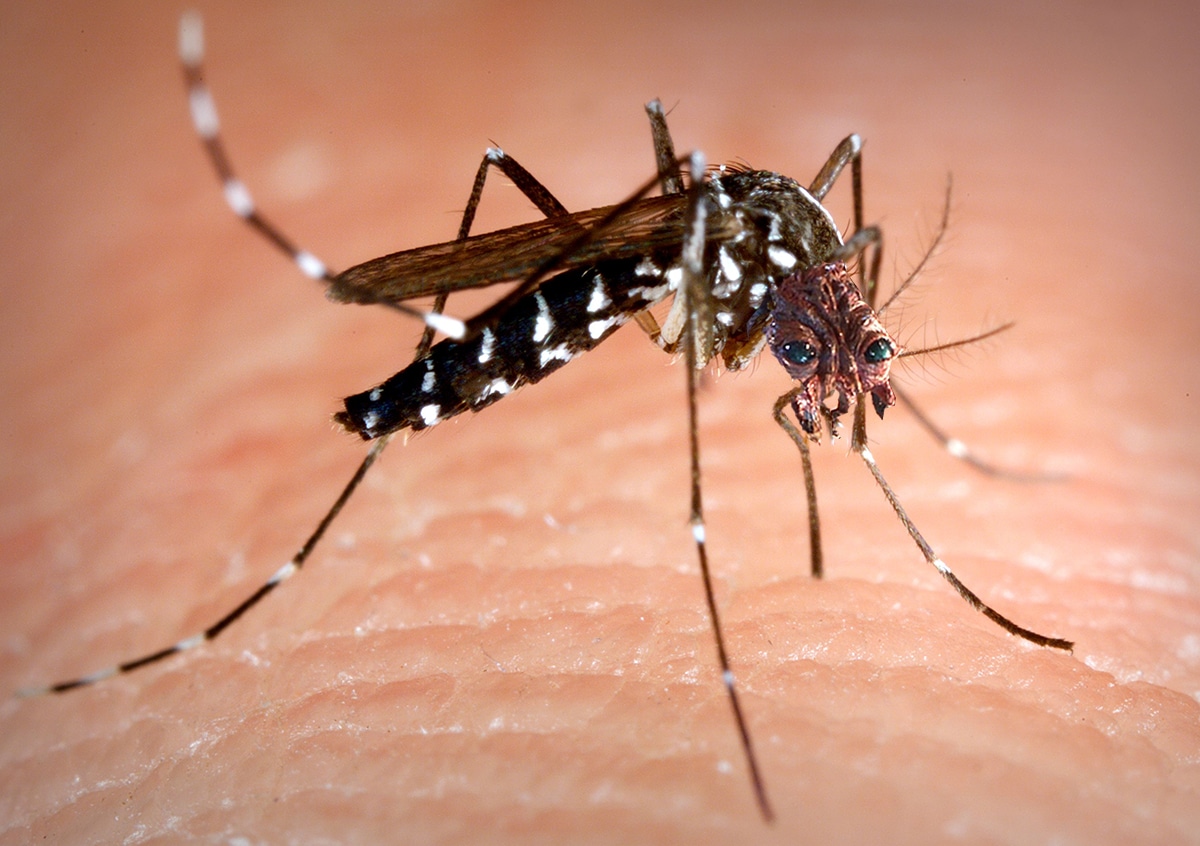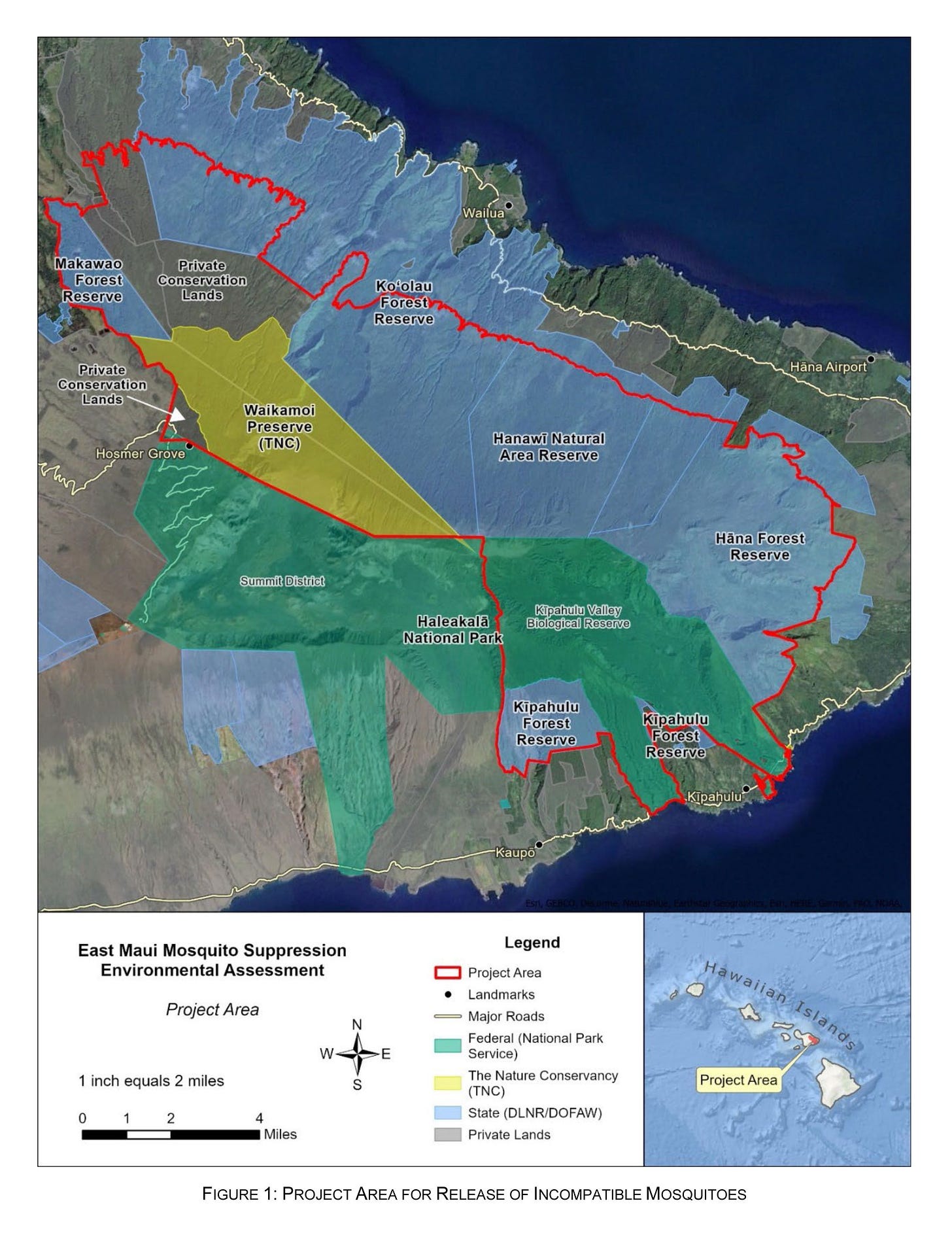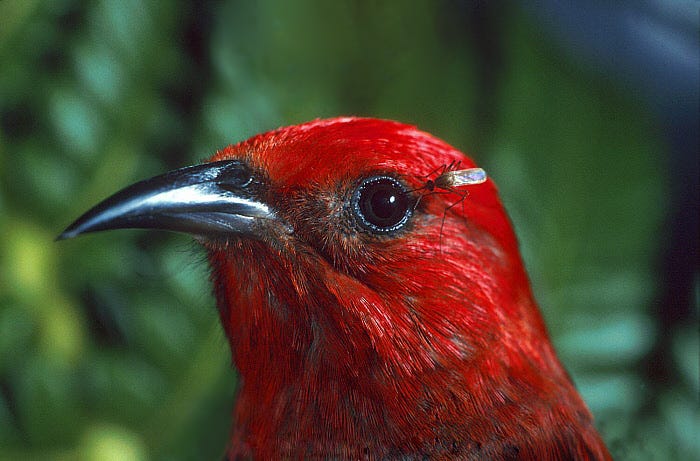

Biotech Experiments: Lab-Altered Mosquitoes in Hawai’i
by Tina Lia – Founder, Hawai’i Unites | Aug 8, 2023
Lab-altered mosquitoes are being released on Maui, and what we’ve discovered in our research about the serious risks posed by these invasive insects and the bacteria they’re infected with is highly concerning. The long-term goals of the agencies involved are even more cause for alarm. We’re headed in a very dangerous direction of corporate experiments, government overreach, and a planned biotech takeover of our natural environment.
Hawai‘i Unites is challenging these mosquito releases in court, and the outcome of our case could change the course of this agenda worldwide. If we can stop this from happening here, we have a better chance of stopping it from advancing to the next targeted location. Could government agencies be negotiating a deal right now for the release of lab-altered mosquitoes and synthetic biology experimentation in your town?
Hawai‘i is widely known as the endangered species capital of the world. Everyone who loves these islands knows that protecting the ‘āina – the land and all its resources – is one of the ways we live with aloha and honor the natural beauty here. Conservation of endemic species is an important focus of these efforts, but when hidden agendas get in the way of critical thinking, the best laid plans of state agency decision-makers can lead to devastating consequences. We’re at the onset of one such plan already being implemented on Maui.
The State of Hawai‘i Department of Land and Natural Resources (DLNR) and its multi-agency partnership Birds, Not Mosquitoes want to release up to 775,992,000 Wolbachia bacteria-infected mosquitoes weekly on the island of Maui’s fragile ecosystems. According to the DLNR’s environmental assessment, these weekly releases would continue for “likely at least 20 years.” The project is presented as an effort to save endangered native birds from avian malaria transmitted by the southern house mosquito (Culex quinquefasciatus). The lab-altered mosquitoes will be infected with a different strain of the bacteria than the existing wild mosquitoes. The process is called “Incompatible Insect Technique” (IIT), a population suppression method where mating mosquitoes with incompatible Wolbachia strains are anticipated to produce offspring that are not viable.

What is at issue here is the lack of study of the risks of the project, along with the clear conflicts of interest behind the decision to rush the mosquito release plan forward. The public has not been given meaningful participation in the decision-making process, and the agencies involved have railroaded this project through despite overwhelming opposition from the people of these islands. Our organization, Hawai‘i Unites, has filed a case in environmental court seeking a ruling to require a comprehensive Environmental Impact Statement (EIS). We’re asking for further study of the serious risks to our environment, native birds, wildlife, and public health; and for consideration of alternatives. The project area includes remote forest conservation sites and endangered species habitats. Despite our active case, DLNR partners have already begun releasing mosquitoes in East Maui. We’re in the process of a hearing for a temporary restraining order and preliminary injunction filed to stop these releases.

Hawai‘i Unites Rally to Protect the ‘Āina (Maui 1/14/23)
This mosquito proposal meant to save native honeycreeper birds may actually lead to their extinction. Peer-reviewed studies have shown that Wolbachia bacteria can increase pathogen infection and can cause mosquitoes to become more capable of transmitting avian malaria and West Nile virus (bird and human). Alarmingly, the potential for increased disease transmitting capability from the combination of the specific bacteria strain infecting the southern house mosquito species being used here has not even been studied prior to release. Our island home is being turned into a testing ground for the biotech industry that profits from these mosquito technologies.
Native Hawaiian honeycreepers are deeply connected to the culture and ancestry of these islands. They’re a symbol of a sacred connection to the natural world that is the soul and spirit of Hawai‘i. The East Maui project area holds powerful meaning to the Hawaiian people as a site of historical significance – of storytelling, chant, song, and legend. For centuries, it has been an important location of native resources, plants, watersheds, endemic species, and cultural practices. This targeting of ancestral lands by corporate interests cuts right to the heart of generations of occupation and desecration that lay the foundation for the story unfolding here today.

‘Apapane honeycreeper
There is no question that this mosquito plan is an experiment. The southern house mosquito has never been used before for Wolbachia IIT stand-alone field release. At 64,666 acres, the East Maui project area is the largest Wolbachia mosquito release of any kind globally to date. The U.S. Department of the Interior confirms that “Wolbachia IIT is a novel tool for conservation purposes and its degree of efficacy in remote forest landscapes is unknown.” The suppression technique being used here is not the same as the population replacement method commonly used globally. Suppression is costly, not self-sustaining, and requires the continuous release of a very large number of mosquitoes indefinitely.
The agencies involved in this project have expressed a startling disregard for the potential impacts of this plan on not only the wildlife and environment, but on human health. In addition to spreading diseases that could harm birds, including avian malaria and avian pox, southern house mosquitoes also transmit human diseases like West Nile virus (which affects birds, too), elephantiasis, St. Louis encephalitis, and Western equine encephalitis; and they’re a potential vector of Zika virus. Some of these diseases affect animals as well, and southern house mosquitoes also transmit heartworm. Male mosquitoes can spread pathogens to wild females through mating. Pathogen screenings of the lab-infected mosquitoes are unknown. Hawai‘i Unites filed a Freedom of Information Act (FOIA) request with the EPA for the documents describing the manufacturing process and pathogen screenings. These documents have been withheld from the public as confidential. Secrecy about these details is highly concerning, particularly since there are no known biosecurity protocols for these incoming mosquitoes and no documented mitigation plan in place if something goes wrong.

Elephantiasis transmitted by the southern house mosquito
Agency partners have openly admitted that female mosquitoes will be accidentally released along with the intentional males. The sorting process is imperfect, and while the anticipated number of females released as stated by project proponents continues to fluctuate, the official documented number remains constant. The bottom line is that EPA guidelines allow for one female to be released with every 250,000 males. For the Maui project area, that could amount to over 3,000 female mosquitoes released weekly. Females bite, breed, and spread disease. Lab-infected females can mate successfully with the lab males released, producing viable offspring. Just one accidentally released female can produce 160,000 more females through breeding of the generations in her eight-week lifespan. In Singapore, as little as 3 females released caused the population to be replaced with the lab-strain mosquitoes. Because there are no studies of the effects of the lab Wolbachia strain on disease transmitting capability, we have no way of knowing how a sweep of lab-strain mosquitoes could affect our native birds, wildlife, or public health.

Wolbachia bacteria is a potentially dangerous life form that cannot be contained once released into the environment. Strains of Wolbachia in parasitic worms play a role in diseases including elephantiasis, heartworm, and river blindness. DLNR partners have repeatedly told the public that no foreign bacteria are being introduced, and that the mosquitoes and Wolbachia are already here on the island. This an outright lie. The State of Hawai’i Department of Agriculture’s Section 18 EPA application for emergency exemption for use of these mosquitoes as a biopesticide (“DQB Males”) states:
“The DQB line of mosquitoes was developed through transfection of Wolbachia pipientis wAlbB isolated from Ae. albopictus KLP strain mosquitoes originating from Kuala Lumpur, Malaysia into Culex quinquefasciatus Palmyra strain mosquitoes originating from Palmyra Atoll.”
While the specific details of this manufacturing process are not being disclosed, these foreign bacteria – along with mosquito lineage from outside of the islands – will be introduced. Additional strains will also be brought over in connection with the plan. One of those strains, wPip4, does not currently exist here in Hawai‘i.

What’s also being withheld from the public are the details of a parallel program being run through the Hawai‘i Department of Health (HDOH), agency partners in the avian malaria project. In addition to southern house mosquitoes, two more species are planned for import into Hawai‘i – Aedes aegypti and Aedes albopictus. Both Aedes species transmit dengue fever, chikungunya, and Zika virus, and the Aedes aegypti transmits yellow fever. On June 28, 2022, the Hawai‘i Board of Agriculture approved the addition of all three mosquito species to the list of restricted animals for research and exhibition. The DLNR’s environmental assessment confirms that approvals are already in place for ground release of lab-infected mosquitoes using cars, trucks, or ATVs “to control mosquitoes of public health concern.” All islands are being targeted with a proposal to cover statewide releases. The secrecy around this mosquito program focused on human diseases speaks to a hidden agenda that appears to be motivating the DLNR’s push to bring lab-altered mosquitoes into the state – advancing a never-ending cash cow of biotech research and development.

Maui Final Environmental Assessment; USGS/UH Hilo Technical Report HCSU-103

USGS/UH Hilo Technical Report HCSU-103
It turns out that the DLNR already has a laboratory here in Hawai‘i, and that lab has been funded by unknown sources to build out an “insectary that will be equipped with a containment biobubble to maintain tool efficacy and meet both federal and state permitting requirements regarding an Arthropod Safety Level 2 (ASL-2) facility.” Mass production of lab-altered mosquitoes in-state for release on the islands is the goal. The intention is for this lab production and release of mosquitoes to continue in “perpetuity” (forever). Federal funding through the U.S. Department of the Interior for just the avian malaria phase of the state’s plan is already coming in at over $30 million. Over $14 million has been secured from the Bipartisan Infrastructure Package enacted in 2021, and an additional $16 Million is coming into the state through the President’s 2023 Investing in America Agenda to Prevent the Imminent Extinction of Hawaiian Forest Birds. Grants, partnerships with mainland universities, and public and private funding are anticipated to incentivize the use of lab-altered mosquito technology in Hawai‘i well into the future.

USGS/UH Hilo Technical Report HCSU-103
In an irrefutable conflict of interest, the proposing agency for the avian malaria mosquito release project, the DLNR, had their own Board of Land and Natural Resources vote to approve the Wolbachia IIT plan for Maui knowing that the DLNR would benefit through funding and future production in their Hawai‘i mosquito lab.
All of this is being implemented without the consent of the people of these islands. Even more disturbing is the gaslighting by Birds, Not Mosquitoes (BNM) over the intent to release genetically modified mosquitoes. This became a red herring talking point early on, with BNM continually dismissing public concerns on the topic and suggesting that anyone questioning the release of GMO mosquitoes just didn’t understand the science. After all, the Wolbachia-infected mosquitoes planned for release to combat avian malaria aren’t considered genetically modified by the EPA, despite the fact that they’re a genetic control technology. What BNM agencies have left out of the discussion, as well, is that their bigger picture plan is to secure funding for gene drives, synthetic biology control tools, and CRISPR-Cas9 gene editing technology. Native bird conservation via lab-altered mosquitoes is a trojan horse proposal meant to open the door to a biotech industry takeover of our natural environment and resources.
The DLNR is anticipating production in their insectary of mosquitoes genetically modified using CRISPR technology for release on the islands. Development of the GMO CRISPR tech, called “precision-guided Sterile Insect Technique” (pgSIT), is advancing through the mainland University of California San Diego. Based on the “emergency” exemptions and fast-tracking of the Wolbachia biopesticide mosquitoes, we anticipate formidable challenges ahead to stop this next phase of bioengineered pollution of our ecosystems.

USGS/UH Hilo Technical Report HCSU-103
At odds with honoring the sacred ancestral connections of the native birds that this current avian malaria mosquito project purports to protect, scientists at agency partner the U.S. Geological Survey are openly promoting genetic modification of the forest birds themselves. Using a process called “facilitated adaptation,” the plan is to genetically modify native ‘i‘iwi honeycreepers to be resistant to malaria using CRISPR-Cas9 gene editing. The birds would then be released into the wild. As with all GMOs, this could result in a takeover of the natural ‘i‘iwi bird population, and with CRISPR comes the additional risks of off-target effects – unintended gene editing and mutations. While, according to the state, “technology for this approach is not available for near-term implementation,” development and deployment of this “tool” does appear to be a goal at the federal level.

‘I‘iwi honeycreeper
Further, one area of the East Maui lands comprising the 64,666-acre project area for the current mosquito releases has a particularly complicated history with at least two agencies involved in the plan. In the 1970s, agency partner The Nature Conservancy (TNC) purchased lands in Kīpahulu that were said to not have clear claim or titles. According to a 2016 article in The Progressive magazine,
“The group then donated this land to the Haleakalā National Park. In one transaction, natives lost their historic lands because they lacked the proper paperwork. Not a good start for the conservancy in the Hawaiian community.”
With the East Maui community actively opposing the use of these ancestral lands to conduct lab-infected mosquito experiments that put the people, wildlife, and environment at risk, it seems TNC and agency partner the U.S. National Park Service are once again at odds with doing what is pono, or righteous.

East Maui Sign Waving (Hāna 7/20/23)
The disturbance to our natural environment, along with the refusal of the DLNR and its board to require study of the potential risks of the project, do bring into question whether or not this plan is actually focused on the wellbeing of native birds. Helicopters and drones are being used to release the mosquitoes in packaging that will litter the forest floor and canopy, with “many thousands of release packets” to be “dropped across the project area throughout the duration of the project” (20+ years? forever?). No information has been disclosed about how long that packaging will remain in our ecosystems. Up to 134 drone flights are planned weekly. Noise disturbances from helicopter and drone releases may cause disruptions to forest bird breeding and nesting, stress to the birds, and interference with birds communicating with each other. The environmental assessment even states that “it is possible that a drone could inadvertently fly into a flock of birds.” How is any of this in alignment with protecting endangered wildlife and the ‘āina?

Maui Final Environmental Assessment
We are in a race against time to halt this project until the impacts to our environment have been extensively studied and safer alternatives explored. Funding at the federal level has been cleverly tied to Hawai‘i’s climate, natural resources, conservation areas, and water sources, along with Native Hawaiian culture, language, and history. Biotechnology is a major component of these initiatives. Last year, the White House issued an Executive Order on Advancing Biotechnology and Biomanufacturing Innovation for a Sustainable, Safe, and Secure American Bioeconomy stating:
“For biotechnology and biomanufacturing to help us achieve our societal goals, the United States needs to invest in foundational scientific capabilities. We need to develop genetic engineering technologies and techniques to be able to write circuitry for cells and predictably program biology in the same way in which we write software and program computers; unlock the power of biological data, including through computing tools and artificial intelligence; and advance the science of scale‑up production while reducing the obstacles for commercialization so that innovative technologies and products can reach markets faster.”
With the backing of our federal government, these agencies and their public and private partners intend to use the Hawaiian Islands as a testing site for experiments in synthetic biology. The natural world is at risk of being polluted and overtaken by lab-altered biotechnology.

Southern house mosquito (Culex quinquefasciatus)

Hawai‘i Unites Rally to Protect the ‘Āina (Maui 1/14/23)
Maui is ground zero for the first phase of this experiment, and the island of Kaua‘i is already being fast-tracked as the next mosquito release site. All islands are at risk. Our case in environmental court could set a strong precedent for stopping this dangerous agenda from moving forward here in Hawai‘i and from expanding globally. Please support our efforts by sharing the story documented at HawaiiUnites.org about this travesty being imposed on our island home.
We are in dire need of funding to continue navigating this case in court. Your tax-deductible donation could mean the difference between conservation of the sacred natural lands here in Hawai‘i and the implementation of an irreversible plan to desecrate our fragile environment through biotech commercialization. Please stand united with us to protect the native birds, the ‘āina, and the health of Hawai‘i’s people and wildlife. The future of all the world’s ecosystems is at stake.



